36
Views & Citations10
Likes & Shares
The world economy was shifting to new ones. The tourism industry is also changing with new concepts. The local visitors’ behavior has also changed from traditional ones to new ones in last few decades. Currently, Myanmar tourism industry mainly focused on exploring the experience economy for travelers. Thus, this study aims to examine the effect of memorable tourism experiences on revisit intention. The purposive sampling method was used in this study. The target respondents were travelers who had experience hiking. Although, the questionnaire was distributed to 150 people, only 140 of them were valid for this study. The descriptive analysis and multiple regression methods used to test the proposed hypotheses. This study found that refreshment, involvement, meaningfulness, and surprise experiences have a positively significant effect on revisit intention.
Today, the tourism industry is shifting to provide memorable experiences to tourists. This movement started when tourist destinations recognized that they needed to offer more than historical places, sun, sand, and sea to attract visitors. The experience economy has become the major focal point for the tourism industry by competing to offer the unique experiences. Thus, memorable tourism experiences have the high interest topic for scholars since a few decades ago.
Tourism practitioners and specialists try to innovate the travel package in various forms. Tureac, (2008) categorized the types of tourism by using various criteria. According to the Tureac research works, there were nine criteria for grouping the tourism forms. These criteria were the initial area and destination, number of participants, organizational criteria, criterion season, temporal criterion, transportation vehicle, social criterion, age and occupation of the criterion, and type of destination.
In Myanmar, domestic travelers’ keen interest in traveling to the famous pagodas in the past. The traveling behavior of domestic travelers was changing in those days. Domestic travelers seek out new destinations for exciting and memorable experiences. Hiking and trekking are the newly forms of travel for domestic travelers. Domestic tourists want to get new exposure for traveling by testing the new mode of travel that is popular in Myanmar. According to the beautiful natural sense, cool weather, hospitality mindset of local residents, and low risk destination, hiking tourism in Kalaw (beautiful city of Southern State, Myanmar) has attracted both local and international tourists. The research on hiking tourism of Kalaw township was limited, especially for memorable tourism experiences. Therefore, this research work tries to study the effect of memorable tourism experiences on the revisit intention of Kalaw hiking tourism in Myanmar.
OBJECTIVES OF THIS STUDY
The major objective of this study is to examine the effect of memorable tourism experiences on the visit intention of local travelers to Kalaw Hiking.
The specific objectives of this study are:
- To examine the effect of hedonism on revisit intention.
- To analyze the effect of novelty on revisit intention.
- To analyze the effect of refreshment on revisit intention.
- To investigate the effect of meaningfulness on revisit intention.
- To determine the influence of knowledge on revisit intention.
- To examine the effect of involvement on revisit intention.
- To explore the effect of local culture on revisit intention.
- To analyze the effect of surprise experiences on revisit intention.
LITERATURE REVIEW
Experience Economy
In the last years of the 20th century, Pine & Gilmore, (1998) wrote the new articles at Harvard Business Review. The name of this article was “Welcome to the Experience Economy”. This article focuses on how the world economy is changing in the real world. They introduced the term "service economy in economic and business literature. According to their explanations, experiences are an individual concern, particular ones depend on the person’s perceptions of events. It can reflect the response to the service delivery process of firms that are more difficult to control on their own.
Zhang, (2010) contended that the emergence of an experience economy depends on the changing of contextual factors. Before Zhang's work, (Knutson & Beck,2004). pioneered the three contextual factors for the experience economy, 1) shock of technology, 2) changing consumers’ buying behavior, 3) intensifying competition among firms. In the age of the experience economy, determining, designing, and delivering the appropriate service design with a greater focus on customers' emotions was critical for service firms.
Memorable Tourism Experience
The very first example of an experience economy was the tourism industry, which is evidenced in early-year literature (Cohen, 1979). In this age, many scholars advocate that tourism experience is a subjective emotional state of tourists (Larsen, 2007). In those literature works, memorable tourism experiences (MTEs) were organized from tourism experiences. There were many factors compromised for tourism experiences. According to (Sharma, & Nayak, 2019). literature works, everything physically works, social factors, tourism services and products, and internal factors such as tourists' motivation, perceptions about tourism products can be recognized as memorable tourism experiences. The research scholars conducted the research to confirm the components of memorable tourism experiences (MTEs). Among these scholars, Kim, (2012) developed the 7-component MTEs scale, and Chandral, (2015) introduced the 10 components for MTEs scale. After these two scholars’ groups, various researchers developed the various components in later studies for MTEs. This study highlighted the 8 components for MTEs using 29 indicators. These 8 components and working definitions are shown in Table 1.
REVISIT INTENTION
Ajzen, (1991) developed the theory of planned behavior that stated the human behavioral intention. These explanations well work for analyzing the human behavior regard with social sciences. This TPB (theory of planned behavior) tries to explain consumer behavior in different context. Among of these different fields, concept of tourists’ revisit intention studied by Tousn, (2015).
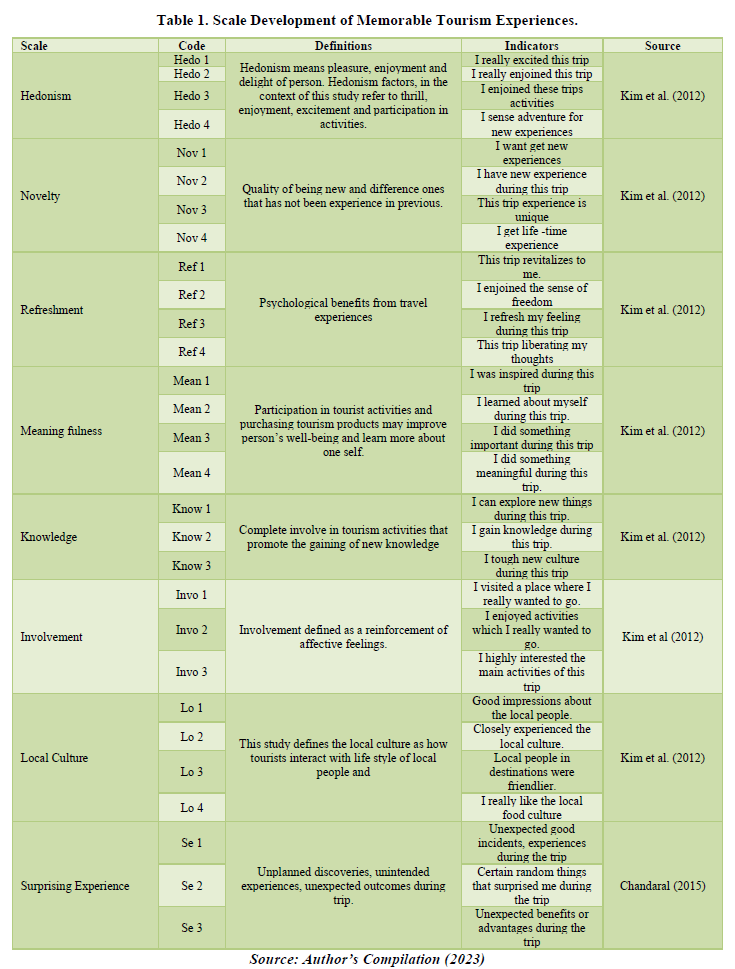
We can simplicity define the revisit intention as repeat visit to one destination for different purposes. Moreover, various scholars try to define the concept of revisit intentions of tourists. Gitelson & Crompton, (1984) found that revisit intention is an important factor for the tourism industry. As mentioned above, re-visit can refer as re-consumption of tourists’ products. The various literature works developed the various factors that influence the revisitation intentions of tourists. This study examines the effect of memorable tourism experiences on the revisitation intentions of tourists. According to this literature, the flowing hypothesis developed for this study-
- H1: Hedonism has a significant and positive effect on the revisitation intentions of tourists.
- H2: Novelty has a significant and positive effect on the revisitation intentions of tourists.
- H3: Refreshment has a significant and positive effect on the revisitation intentions of tourists.
- H4: Meaningfulness has a significant and positive effect on the revisitation intentions of tourists.
- H5: Knowledge has a significant and positive effect on the revisitation intentions of tourists.
- H6: Involvement has a significant and positive effect on the revisitation intentions of tourists.
- H7: Local culture has a significant and positive effect on the revisitation intentions of tourists.
- H8: Surprising experiences have a significant and positive effect on the revisitation intentions of tourists.
RESEARCH METHODS
This research is designed as an explanatory research. This research work builds the conceptual frame by reviewing the previous literature. The survey method used for the data collection process. A structured questionnaire was used to measure the constructive variables in this study. For the memorable tourism experiences (MTEs), eight constructive variables and twenty-nine questions were used by combining the two scholars' works, namely Kim et al. and Chandaral. The questions for revisit intention were six items created by reviewing the previous research works. The self-determinist technique used to collect the required data. This research work used the Cronbach alpha value for the reliability of collected data. Descriptive analysis was also employed for analyze the collected data. This study majority used the correlation test and multiple regression analysis test for the proposed research hypothesis.
RESULTS AND DISCUSSIONS
- Profile of Respondents
The questionnaire was distributed to 150 respondents. The answers of 140 respondents were valid, and we ignored the rest (10 respondents) because they were not incomplete answers to the survey questionnaire. Thus, the valid response rate is 93.3%. Most of the respondents were female (75%), their age mostly spread around 31- 40 (34%), most of them were graduated (48%) and have been working for corporate staff (51%). The other things of demographic contents depicted in Table 2.
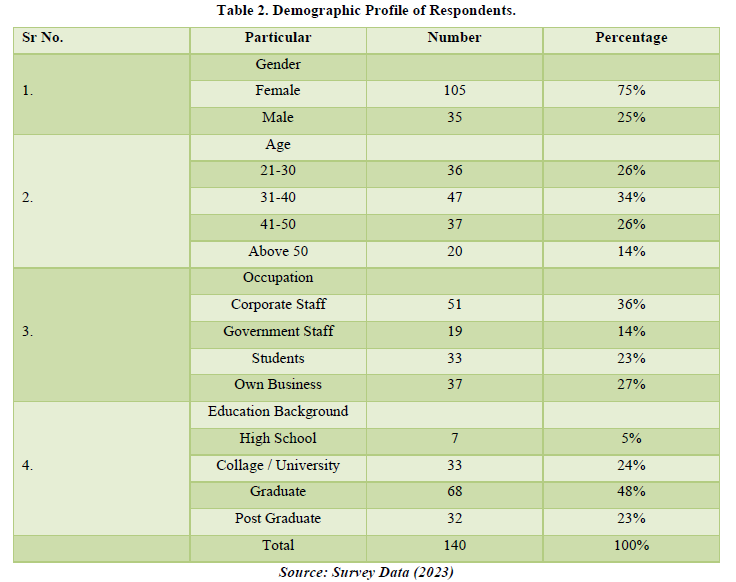
- Reliability Analysis
Table 3 presents the reliability of each variable that used in this study. This study used the Cronbach’s alpha analysis on the dependent and independent variables in order to determine the reliability of the instrument is used to measure the internal consistency of test. The coefficient of reliability reaches between “0” and “1”. The internal consistency of variables better when the value of Cronbach alpha near to “1”. The Cronbach value of each scale items shown in Table 3.
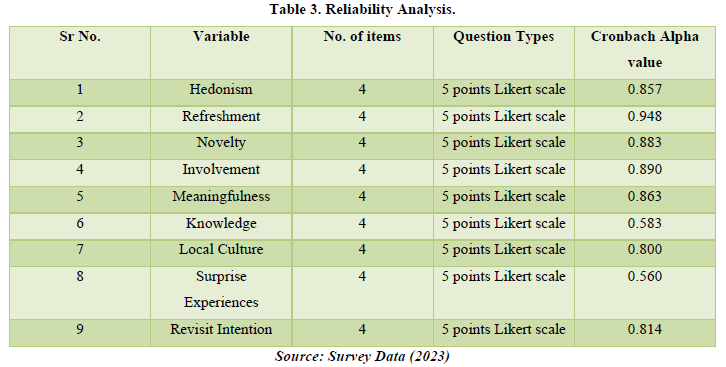
- Correlation Analysis on Memorable Tourism Experiences (MTEs) and Revisit Intention
In this section, we are going to examine the relationship between dependent and independent variables. Memorable tourism experiences (MTEs) used as independent variables, compromised with 8 cohort variables, and revisit intention was assumed as a dependent variable. For this study, the Pearson correlation analysis technique was applied in order to test the relationship of dependent variable and independent variables. Saunders & Lewis, (2012) proposed using the Pearson correlation coefficient to test the linear relationship between dependent and independent variables. This coefficient is normally denoted with the letter “r”. The value of “r” near to “0” means that the data do not correlate with each other. In other side, the value of “r” near to “+1 or – 1” means that it may be a positive or negative relationship with each other’s. The results of this analysis are mentioned in Table 4.
According to the result of correlation analysis, the correlation range of dependent variable and independent variable was rounded to "1,” which indicates the strong relationship between memorable tourism experiences (MTEs) and revisit intention.
- Regression Analysis on the Effect of MTEs on Revisit Intention
The regression analysis employed to examine the effect of memorable tourism experiences (MTEs) on revisit intention of visitors to Kalaw hiking trips. The multiple regression model for the research hypotheses was developed as follows:
Whereas:
Yi: mean of revisit intention for itth respondents; X1i: mean of hedonism; X2i: mean of refreshment; X3i: mean of novelty; X4i: mean of involvement; X5i: mean of meaningfulness; X6i: mean of knowledge; X7i: mean of local culture; X8i: mean of surprise experience.
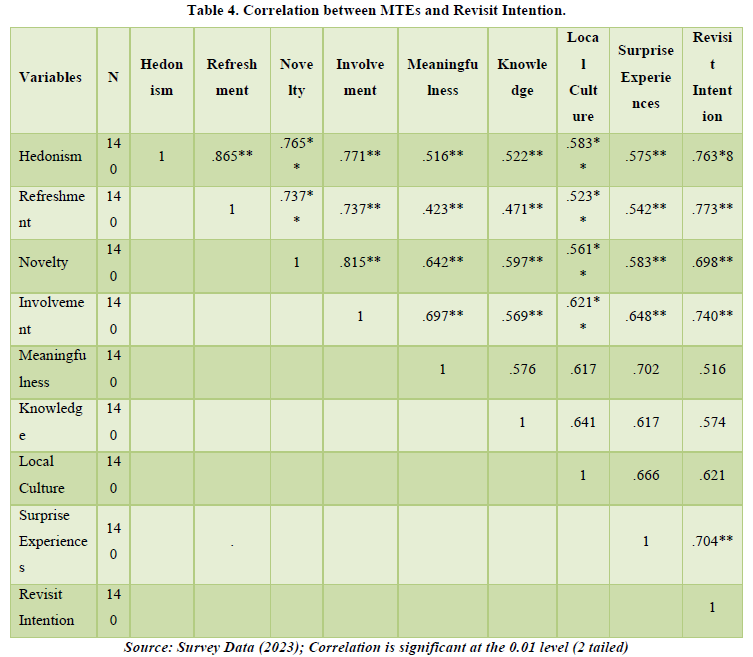
The results presented in Table 5 highlight the fitness of the regression model in explaining the study phenomena. The attributes of MTEs determined to be the determinant factors for revisit intention. This is supported by coefficient determination of R square of 75%. This means that MTEs attribute 75% variations in the dependent variable, which is revisited intention. The result of this model fitness is described in Table 5.

Table 6 provides the results of regression coefficients that examine the effect of MTEs on revisit intention. This result highlighted the refreshment, surprise experience, and revisit intention are positively significant related (β = .221, p = .003), (β= .365, p = .000) at 1% level. The table further indicates that involvement, meaningfulness, and revisit intention are positively related (β = .172, p = .045), (β = .166, p = .030) at 5 % level. Thus, the optimal model for this research is: revisit Intention = .288 + .221 refreshment + .172 involvement + .166 meaningfulness + .365 surprise experience.
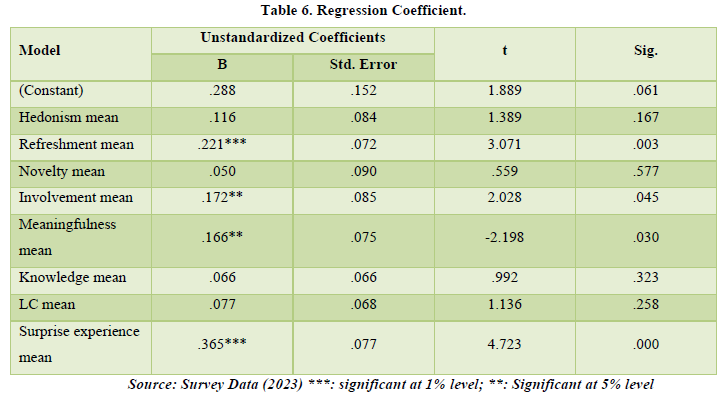
- Hypothesis Testing
This section discussed the hypothesis testing of the study variables. The rule of thumb was to accept the proposed hypothesis if the independent variables (attributes of MTEs) significant relationship with the dependent variable. The significance was tested at the critical P value of 0.05. Table 7 presents the hypothesis testing.
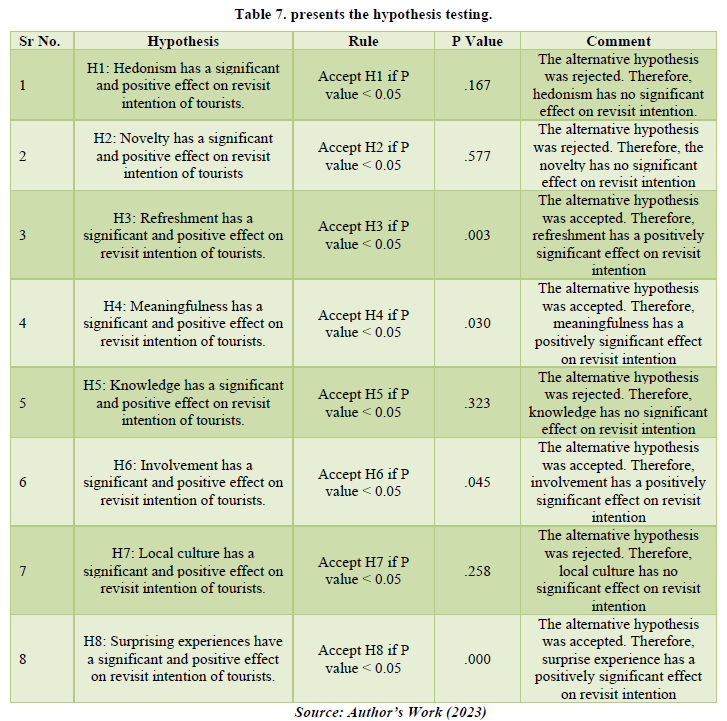
CONCLUSION
As a pioneering study for the Myanmar tourism industry, this research tries to examine the effect of memorable tourism experiences (MTEs) on the revisit intention of local visitors to Kalaw hiking. The correlation analysis and multiple regression analysis tests were conducted to examine the proposed research hypothesis. Thus, this research concludes with the following points: the first is that refreshment and surprise experiences have a significant positive effect on revisit intention at 1% level. The second is that involvement and meaningfulness have a positive and significant effect on revisit intention at the 5% level.
- Recommendation
Based on these findings, this study recommends that tour firms develop travel packages for visitors that seem to refresh their traveling moods. Moreover, tour practitioners can create tour packages that surprise visitors during their hiking journey. For example, creating events that excited the visitors. The other recommendation for the local authority is to create the necessary tourist infrastructure for visitors to be more convince during their trips. For instance, make the safety zone for hiking destination and so on.
- Areas for further Studies
This study sought to find the effect of memorable tourism experiences on Kalaw hiking tours. Thus, further studies can also be considered for other tourism destinations in Myanmar, such as Pyin Oo Lwin, Hpa An. Additionally, other studies should focus on effecting on revisit intention, such as destination image, perceived risk, tourist satisfaction, and so on.
- Ajzen, I. (1991). The theory of planned behavior. Organizational Behavior and Human Decision Processes, 50, 179-211.
- Chandralal, L., Valenzuela, F. (2013). Exploring memorable tourism experiences: antecedents and behavioral outcomes. Journal of Economics, Business and Management, 1, 177-181.
- Cohen, E. (1979). A phenomenology of tourist experiences. Sociology, 13, 179-201.
- Gitelson, R. J., & Crompton, J. L. (1984). Insights into the repeat vacation phenomenon. Annals of tourism Research, 11, 199-217.
- Kim, J.H., Ritchie, J.R.B, and McCormick, B. (2012). Development of a scale to measure memorable tourism experiences. Journal of Travel Research, 51, 12-25
- Knutson, B. J., Beck, J. A., & Yen, H. H. (2004). Marketing the mid-price independently owned resort: A case study with implications for managers. Journal of Hospitality & Leisure Marketing, 11, 65-79.
- Larsen, S. (2007). Aspects of a psychology of the tourist experience. Scandinavian Journal of Hospitality and Tourism, 7, 7-18.
- Pine II, B.J.; Gilmore J.H. (1998). Welcome to the experience economy. Harvard Business Review, 76, 97-105.
- Rojon, C., & Saunders, M. N. (2012). Formulating a convincing rationale for a research study. Coaching: An International Journal of Theory, Research and Practice, 5, 55-61.
- Sharma, P., & Nayak, J. K. (2019). Understanding memorable tourism experiences as the determinants of tourists' behavior. International Journal of Tourism Research, 21, 504-518.
- Tosun, C., Dedeoğlu, B. B., & Fyall, A. (2015). Destination service quality affective image and revisit intention the moderating role of past experience. Journal of Destination Marketing & Management, 4, 222-234.
- Tureac, C. E., & Turtureanu, A. (2010). Types and forms of tourism. Acta Universitatis Danubius Economica, 4.
- Zang J. (2010). “The Coming Era of Experience Economy and Breakthrough of Service Innovation Dilemma”. International Conference on Management and Service Science. Available online at: http://ieeexplore.ieee.org/xpls/abs_all.jsp?arnumber=5577130
- Zhang (2010). Tourists' attitudes toward tea tourism: A case study in Xinyang, China. Journal of Travel & Tourism Marketing, 27, 211-220.

